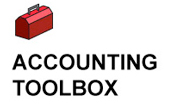The accounting profession requires an analytical process. Critical thinking includes the use of analytical processes. Beyond the basics of journal entries and preparing financial statements in accordance with Generally Accepted Accounting Principles, an accountant should be able to analyze, project, and explain financial data.
Critical thinking requires the following four steps:
- determine the problem
- examine the available data
- model possible results or forecast impacts
- communicate and explain the analysis
The skills needed often reach beyond traditional accounting into economics, operations research, and statistics.
1. Determine the Problem
This is also known as "establishing the problem statement." The techniques you may remember from algebra word problems or from identifying the topic sentence in an English assignment follow the same principles: from the given information, determine what issues need to be addressed. It could be as simple as comparing current and prior-period financial results, or it could be forecasting revenue trends for the next five years. Both begin with establishing the problem statement.
There are many resources and books on critical thinking and how to establish a problem statement and critique it for fallacies. As you define and explore the topic of critical thinking, consider these sources:
- Critical Thinking, by Brooke Noel Moore, Richard Parker
- Miniature Guide to Critical Thinking, by Richard Paul, Linda Elder
- The Thinker's Guide to Analytic Thinking, by Linda Elder, Richard Paul
Foundation for Critical Thinking
Offers free sample downloads of materials by Elder and Paul, the authors mentioned above.
UMUC also offers courses in philosophy that address critical thinking. Among them is PHIL 110: Practical Reasoning.
2. Examine the Available Data
The second step is to determine what data is pertinent and available. Following the example above, if the need is to compare current and prior-period financial statements within the same company, the process should be fairly straightforward: compare how each financial statement line changed from period to period and highlight any unusual results. However, if the task is to analyze a financial statement against industry performance, or another company within the same industry, that requires research into industry trends.
Trade Associations
The first research site would be an industry's trade association, such as the ones below. Each presents industry statistical information.
The Association of American Railroads
The National Association of Manufacturers
The Motion Picture Association of America
Research Firms
There are research firms that specialize in developing industry trends. While far from being an exhaustive list, you can think about using:
Macroeconomic Forecasts for Emerging Markets - Business Monitor Online
The federal government also provides some industry analysis:
Federal Deposit Insurance Corporation (FDIC)
For the banking industry.
FCC Media Bureau Industry Analysis
For the telecommunications and media industries.
U.S. Securities and Exchange Commission
For Form 10-K business filings.
The Bureau of Economic Analysis
For overall economics.
One readily available tool should be the financial ratios found in Intermediate Accounting. Ratios and Formulas in Customer Financial Analysis is a concise list of regularly used ratios.
American Institute of CPAs Resources offers a collection of information and reports relevant to industry and government.
3. Model Possible Results or Forecast Impacts
Step 3, modeling results or forecasting future performance, moves into the realm of economics, operations research, and statistics. The UMUC accounting major requires at least two economics courses and one statistics course. Additional work in operations research is a good option.
UMUC offers an extensive economics program; the following courses, beyond the courses required for your degree, could supplement your critical thinking skills:
ECON 422: Quantitative Economics
ECON 425: Mathematical Economics is another good course (you must have one semester of calculus)
Finance is another good area in which to learn modeling skills.
FINC 421: Financial Analysis (a course on analytical techniques)
As an accounting major, take the required courses as soon as possible, because they will help you in your accounting courses! Remember that the required statistics course is a prerequisite to your first required finance course:
STAT 230: Business Statistics
Operations Research
Operations research covers multiple processes to help make better decisions. The techniques can assist you in evaluating what mix of products to make, or how to determine what route a train should take to maximize speed, for instance.
Institute for Operations Research and the Management Sciences provides an overview of operations research techniques and uses.
Operations Research | What O.R. Is is another operations research site.
Forecasting
Forecasting—in particular revenue and expenses—is a combination of economic techniques. It requires the industry understanding described above, some knowledge of the organization's future performance, and the overall economic outlook. In all cases, forecasting is an art rather than a science. However, there are approaches that may provide some guidance:
The Fundamentals of Revenue Forecasting
How to Forecast Revenue and Growth
Qualitative Forecasting Methods and Techniques
Forecasting methods and formulas with Excel
Choosing the Right Forecasting Technique
4. Communicate and Explain the Analysis
The final step is explaining the analysis. As mentioned in the earlier component on the communications process, knowing your audience is the key to good communication. Here are a few thoughts on how to communicate and explain a critical thinking project:
- Describe your interpretation of the problem. What factors did you use to analyze the problem? What background did you draw upon? Did you take a known approach or a new one?
- Describe your assumptions and constraints. These can include business constraints, industry trends, or new business opportunities.
- Describe your analysis, the steps you took, the models built, and the forecasts created.
- Finally, using your analysis, provide your recommendations.
Remember that critical thinking is asking the right questions and following up with analysis and communication.
